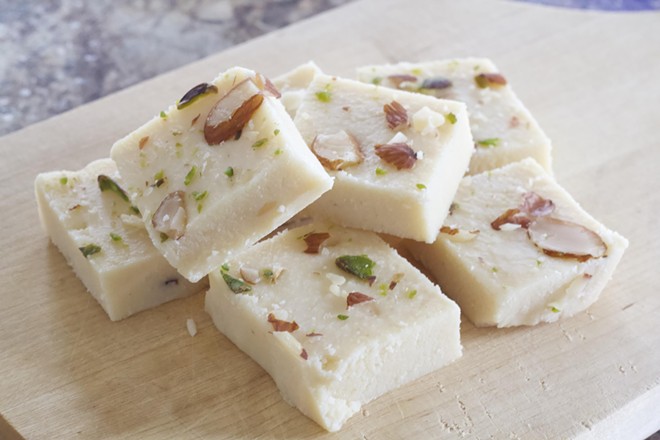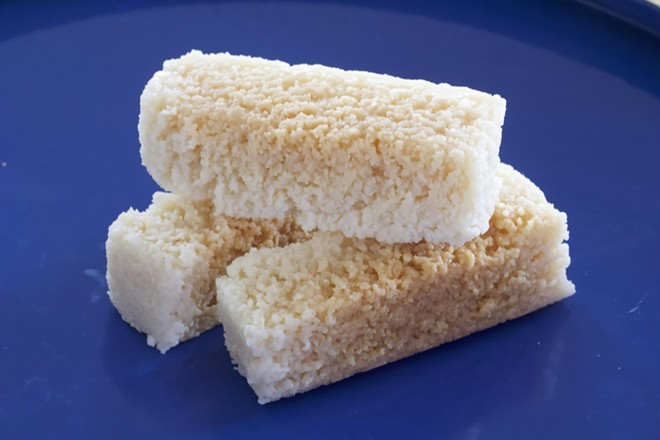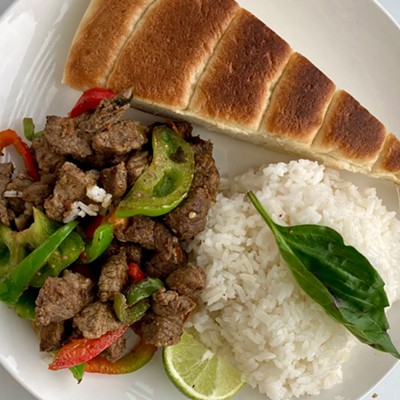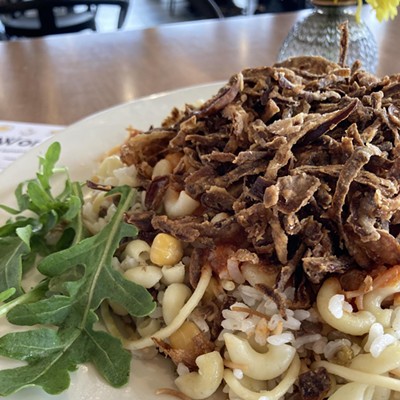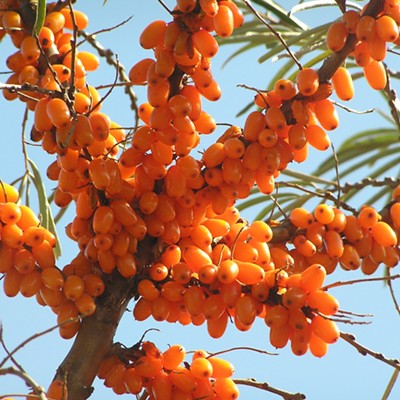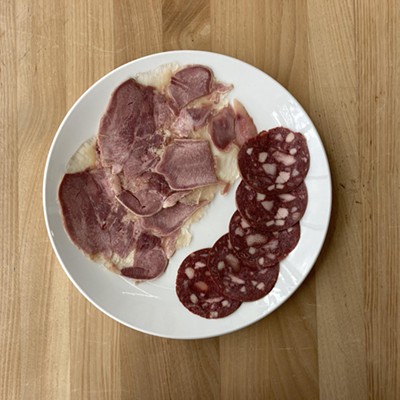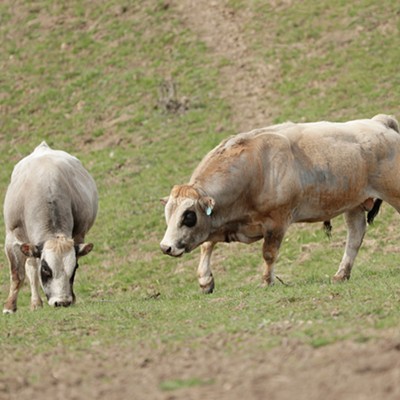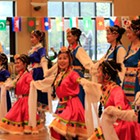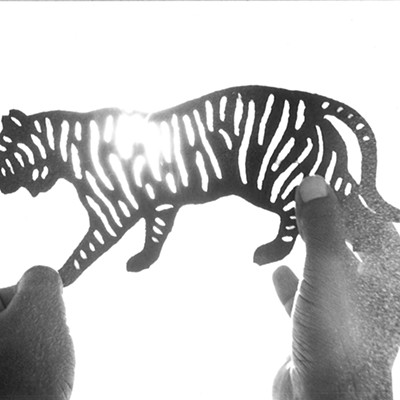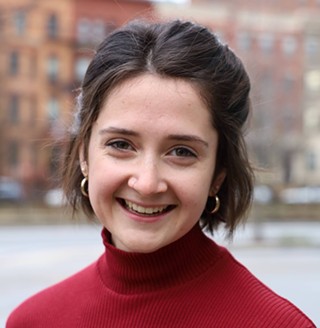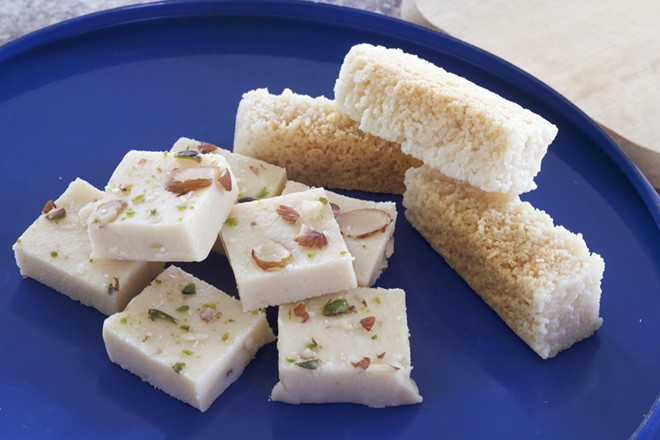
This is an installment of the Inlander's yearlong project "Around the World in 80 Plates," a quest to find 80 foods and drinks in the Spokane area representing 80 different places. Read the introduction to the project here.
Count of dishes/places: 24
Butter. Sugar. Spice. Does the soul need anything else?
Sometimes I get caught up wishing there was a pill I could take to get all my nutrition in the most efficient way possible.
Excess calories? Gone.
Meal prep? Done.
Free time? More.
But happiness? Dismal, probably.
Someone reminded me recently that living optimally doesn't necessarily mean being happy. The "pill" side of my brain cringed. The "dessert" part of my brain rejoiced.
There's a whole bunch of brain chemistry that can explain why the fat + sugar combo of dessert makes me immediately, incomparably happy. But I can never remember it all, so I like to credit it to that catchall, the soul. Dessert is good for the soul. It's completely superfluous from a nutrition standpoint, or potentially harmful, even. But it's important to whatever part of me doesn't idolize efficiency but inspires art and celebration and excess and fun.
When I stopped into Indy Mart Food on Pines Road in Spokane Valley, I gazed across the bags of gorgeous beans and lentils, intriguing spices, jars of ghee and bottles of rose water. The small Indian market attached to a gas station had plenty of exciting, tempting ingredients. But it was the small fridge filled with homemade treats that made me pull out my wallet.
At the end of a middle aisle, facing the back wall, the tiny refrigerator had stacks on stacks of clear plastic containers. They held different Indian desserts made by a local sweet shop, the proprietor told me. Each square, diamond and triangle was topped with an assortment of pistachios, almonds or rose petals, and they were all unlabeled. I snagged a couple of my visual favorites, paid, and taste tested immediately upon getting into the car.
I was in heaven. Turns out, the sweets I chose were different kinds of "milk cakes," simple concoctions of ghee, milk, sugar and a few spices, which were utterly and simply delightful. Like I said, nothing makes me happy like fat and sugar. Add a dash of pistachio, and I'll ditch that pill idea once and for all.
MAWA BARFI FROM DELHI
Amir Khusrow was a 13th century classical Persian poet nicknamed the "parrot of India." From about 1280 to 1325, he was honored in the royal courts of eight Delhi Sultanate sultans — rulers of an Islamic medieval empire that eventually stretched across most of the Indian subcontinent.
Khusrow composed poems and works of history, but he's popularly famous for lots and lots of riddles — ingenious plays on words that take advantage of the double meanings that lurk in every language. For example:
raajaa pyaasaa kyo.n? (Why was the king thirsty?)
gadahaa udaasaa kyo.n? (Why was the donkey sad?)
Answer: loTaa na thaa. (A phrase that means both "had no cup for water" AND "had not rolled on the ground.")
As with most wordplay, a lot of the humor and surprise is lost in translation. But you get the gist — two separate, random questions can be answered with one clever phrase.
Khusrow is also the first person to mention barfi in a preserved written form. Barfi is a milk cake that was popular in the royal courts of Delhi, the capital of the Delhi Sultanate while Khusrow was composing. We know that it was popular because of a riddle Khusrow wrote. "Barfi" comes from the Persian word "barf," which means "snow." The sweet, white milk cake that pleased the sultans was the perfect opportunity for a clever riddle that would be just as satisfying.
Barfi is made from mawa (also known as khoya). Mawa is the resulting milk solids that you get from boiling milk down for hours. The solid mass looks a little bit like fresh mozzarella, and can be grated in a similar way.
Mawa barfi is simply grated mawa and sugar, plus maybe some fresh milk, heated together on the stove until they form a thick dough. It's then left to cool in a pan, until it sets into a sweet fudge.
The texture is somewhere between halva, the popular Middle Eastern sesame treat, and American fudge. The flavor is simple and sweet. Mawa barfi typically doesn't have any other flavoring other than a maybe a quarter teaspoon of cardamom, plus a little nuttiness from the pistachios and slivered almonds that decorate the top.
The sweet treat is a popular gift to give during festivals, especially Diwali, or to serve on special occasions like weddings, where it might be dressed up with the glitz and glamor of some edible silver leaf. Modern confectioners might add other flavors like chocolate, coffee or rose water.
But flavors change the color, which maybe starts to compromise what should be a "snow" dessert. Whatever was good enough for the sultans is good enough for me.
ALWAR KA MAWA FROM ALWAR
Besides Goa, a small state in India that remained a Portugese colony until 1961, India has no tradition of baking desserts. Tandoori ovens are completely unsuited for cakes or pastries, and high caste Hindus don't eat eggs, which severely limits the amount of baked goods they'd be interested in.
So instead, most desserts rely on the stovetop, hence the abundance of sweet treats that start with boiling milk solids and sugars. This abundance also makes it hard to parse which treats are which, at least for an outsider.
But insiders disagree, too. Two oft-conflated milk cakes are Alwar ka mawa and kalakand. Plenty of online discussions try to decide where one ends and the other begins. Reddit channels are dedicated to arguing about whether there is any difference between the two.
Alwar ka mawa is a milk cake that is said to have originated in Alwar, a city just south of New Delhi that's part of the National Capital Region and the northern province of Rajasthan. Supposedly, a Pakistani man left Pakistan for India in 1947 during the time of partition, settled in Alwar, and introduced the city to his favorite milk cake, which then became known as Alwar ka mawa.
A more detailed account of the history of kalakand credits Baba Thakur Das, a Pakistani sweet maker, with an accidental creation of this milk cake. Supposedly, he was going to make Punjabi doodhi, a dessert with milk, ghee and calabash (a common kind of gourd), but the milk curdled when it boiled. Instead of adding the gourd, he let the milk and sugar thicken, then cool. The resulting dessert was sweet and grainy, light on the outside with a deeper caramel color on the inside.
The dessert that I picked out of the fridge had that same caramel color on the inside and had a pleasantly grainier texture than the mawa barfi. Recipes I found for Alwar ka mawa list mawa, ghee and sugar as expected, but also something acidic, which creates the unique texture.
Whatever this milk cake was, it was a melt-in-your-mouth experience, with globules of milky sugar dissolving at the touch of the tongue. Wherever it came from, I’m here for it now. And for me, it’s fierce competition for a brownie, cookie or any other kind of baked good. Just give me sugar and fat, that's all I need. All my soul needs, at least.♦
Have an idea for what I should eat next? Wanna make me a traditional dish from your hometown? Got any hot takes that would spark a food-based debate? Send 80 Plates tips and ideas to [email protected].

